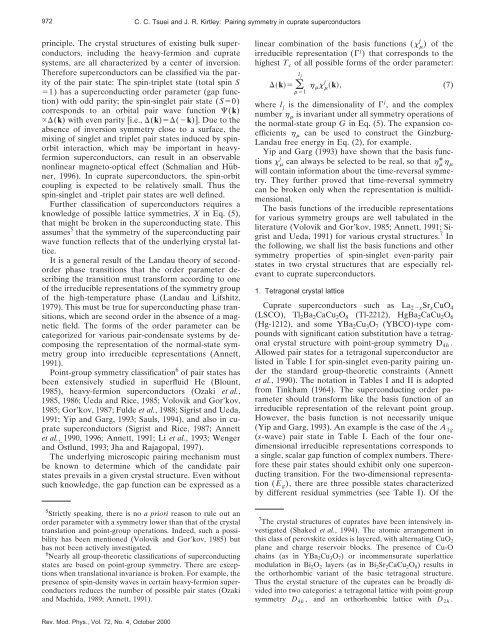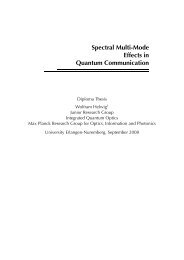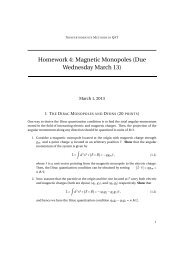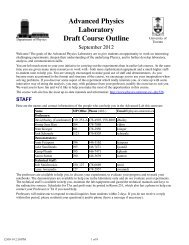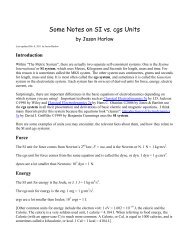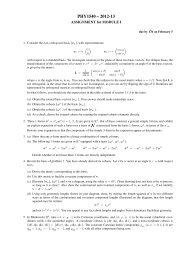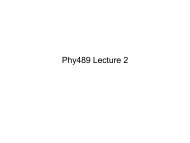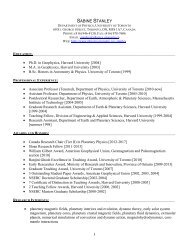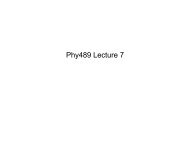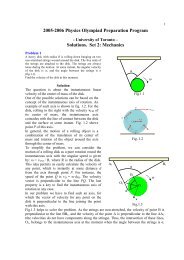Kirtley and Tsuei - Physics
Kirtley and Tsuei - Physics
Kirtley and Tsuei - Physics
You also want an ePaper? Increase the reach of your titles
YUMPU automatically turns print PDFs into web optimized ePapers that Google loves.
972 C. C. <strong>Tsuei</strong> <strong>and</strong> J. R. <strong>Kirtley</strong>: Pairing symmetry in cuprate superconductors<br />
principle. The crystal structures of existing bulk superconductors,<br />
including the heavy-fermion <strong>and</strong> cuprate<br />
systems, are all characterized by a center of inversion.<br />
Therefore superconductors can be classified via the parity<br />
of the pair state: The spin-triplet state (total spin S<br />
1) has a superconducting order parameter (gap function)<br />
with odd parity; the spin-singlet pair state (S0)<br />
corresponds to an orbital pair wave function (k)<br />
(k) with even parity [i.e., (k)(k)]. Due to the<br />
absence of inversion symmetry close to a surface, the<br />
mixing of singlet <strong>and</strong> triplet pair states induced by spinorbit<br />
interaction, which may be important in heavyfermion<br />
superconductors, can result in an observable<br />
nonlinear magneto-optical effect (Schmalian <strong>and</strong> Hübner,<br />
1996). In cuprate superconductors, the spin-orbit<br />
coupling is expected to be relatively small. Thus the<br />
spin-singlet <strong>and</strong> -triplet pair states are well defined.<br />
Further classification of superconductors requires a<br />
knowledge of possible lattice symmetries, X in Eq. (5),<br />
that might be broken in the superconducting state. This<br />
assumes 5 that the symmetry of the superconducting pair<br />
wave function reflects that of the underlying crystal lattice.<br />
It is a general result of the L<strong>and</strong>au theory of secondorder<br />
phase transitions that the order parameter describing<br />
the transition must transform according to one<br />
of the irreducible representations of the symmetry group<br />
of the high-temperature phase (L<strong>and</strong>au <strong>and</strong> Lifshitz,<br />
1979). This must be true for superconducting phase transitions,<br />
which are second order in the absence of a magnetic<br />
field. The forms of the order parameter can be<br />
categorized for various pair-condensate systems by decomposing<br />
the representation of the normal-state symmetry<br />
group into irreducible representations (Annett,<br />
1991).<br />
Point-group symmetry classification 6 of pair states has<br />
been extensively studied in superfluid He (Blount,<br />
1985), heavy-fermion superconductors (Ozaki et al.,<br />
1985, 1986; Ueda <strong>and</strong> Rice, 1985; Volovik <strong>and</strong> Gor’kov,<br />
1985; Gor’kov, 1987; Fulde et al., 1988; Sigrist <strong>and</strong> Ueda,<br />
1991; Yip <strong>and</strong> Garg, 1993; Sauls, 1994), <strong>and</strong> also in cuprate<br />
superconductors (Sigrist <strong>and</strong> Rice, 1987; Annett<br />
et al., 1990, 1996; Annett, 1991; Li et al., 1993; Wenger<br />
<strong>and</strong> Östlund, 1993; Jha <strong>and</strong> Rajagopal, 1997).<br />
The underlying microscopic pairing mechanism must<br />
be known to determine which of the c<strong>and</strong>idate pair<br />
states prevails in a given crystal structure. Even without<br />
such knowledge, the gap function can be expressed as a<br />
5 Strictly speaking, there is no a priori reason to rule out an<br />
order parameter with a symmetry lower than that of the crystal<br />
translation <strong>and</strong> point-group operations. Indeed, such a possibility<br />
has been mentioned (Volovik <strong>and</strong> Gor’kov, 1985) but<br />
has not been actively investigated.<br />
6 Nearly all group-theoretic classifications of superconducting<br />
states are based on point-group symmetry. There are exceptions<br />
when translational invariance is broken. For example, the<br />
presence of spin-density waves in certain heavy-fermion superconductors<br />
reduces the number of possible pair states (Ozaki<br />
<strong>and</strong> Machida, 1989; Annett, 1991).<br />
linear combination of the basis functions ( j ) of the<br />
irreducible representation ( j ) that corresponds to the<br />
highest T c of all possible forms of the order parameter:<br />
l j<br />
k<br />
1<br />
j k, (7)<br />
where l j is the dimensionality of j , <strong>and</strong> the complex<br />
number is invariant under all symmetry operations of<br />
the normal-state group G in Eq. (5). The expansion coefficients<br />
can be used to construct the Ginzburg-<br />
L<strong>and</strong>au free energy in Eq. (2), for example.<br />
Yip <strong>and</strong> Garg (1993) have shown that the basis functions<br />
can always be selected to be real, so that <br />
j<br />
* <br />
will contain information about the time-reversal symmetry.<br />
They further proved that time-reversal symmetry<br />
can be broken only when the representation is multidimensional.<br />
The basis functions of the irreducible representations<br />
for various symmetry groups are well tabulated in the<br />
literature (Volovik <strong>and</strong> Gor’kov, 1985; Annett, 1991; Sigrist<br />
<strong>and</strong> Ueda, 1991) for various crystal structures. 7 In<br />
the following, we shall list the basis functions <strong>and</strong> other<br />
symmetry properties of spin-singlet even-parity pair<br />
states in two crystal structures that are especially relevant<br />
to cuprate superconductors.<br />
1. Tetragonal crystal lattice<br />
Cuprate superconductors such as La 2x Sr x CuO 4<br />
(LSCO), Tl 2 Ba 2 CaCu 2 O 8 (Tl-2212), HgBa 2 CaCu 2 O 6<br />
(Hg-1212), <strong>and</strong> some YBa 2 Cu 3 O 7 (YBCO)-type compounds<br />
with significant cation substitution have a tetragonal<br />
crystal structure with point-group symmetry D 4h .<br />
Allowed pair states for a tetragonal superconductor are<br />
listed in Table I for spin-singlet even-parity pairing under<br />
the st<strong>and</strong>ard group-theoretic constraints (Annett<br />
et al., 1990). The notation in Tables I <strong>and</strong> II is adopted<br />
from Tinkham (1964). The superconducting order parameter<br />
should transform like the basis function of an<br />
irreducible representation of the relevant point group.<br />
However, the basis function is not necessarily unique<br />
(Yip <strong>and</strong> Garg, 1993). An example is the case of the A 1g<br />
(s-wave) pair state in Table I. Each of the four onedimensional<br />
irreducible representations corresponds to<br />
a single, scalar gap function of complex numbers. Therefore<br />
these pair states should exhibit only one superconducting<br />
transition. For the two-dimensional representation<br />
(E g ), there are three possible states characterized<br />
by different residual symmetries (see Table I). Of the<br />
7 The crystal structures of cuprates have been intensively investigated<br />
(Shaked et al., 1994). The atomic arrangement in<br />
this class of perovskite oxides is layered, with alternating CuO 2<br />
plane <strong>and</strong> charge reservoir blocks. The presence of Cu-O<br />
chains (as in YBa 2 Cu 3 O 7 ) or incommensurate superlattice<br />
modulation in Bi 2 O 2 layers (as in Bi 2 Sr 2 CaCu 2 O 8 ) results in<br />
the orthorhombic variant of the basic tetragonal structure.<br />
Thus the crystal structure of the cuprates can be broadly divided<br />
into two categories: a tetragonal lattice with point-group<br />
symmetry D 4h , <strong>and</strong> an orthorhombic lattice with D 2h .<br />
Rev. Mod. Phys., Vol. 72, No. 4, October 2000


